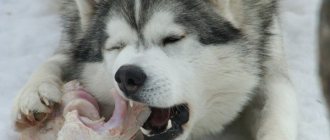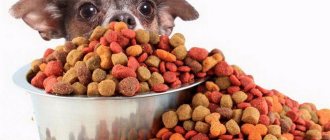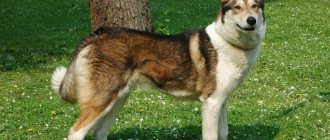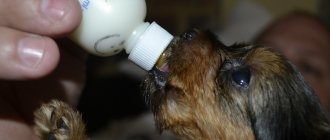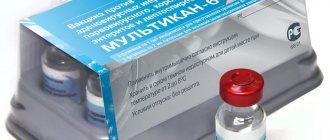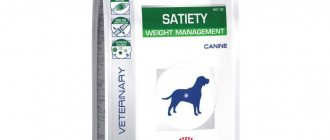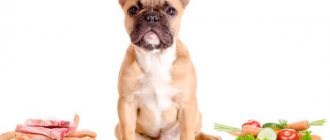You need to approach the choice of diet for your pet responsibly, weighing the pros and cons, taking into account the characteristics of the breed and the state of its health. We have already talked about what is better to feed your dog: dry food or natural food. They also talked about the variety of industrial dry products and told how to choose dry food. Regardless of whether you are going to transition an adult dog to drying or choosing a diet for a newly acquired puppy, there are several rules that are very important for your pet to follow. So, how to feed your dog dry food and how to change the diet so as not to harm the dog’s health?
Is it possible to feed a puppy only dry food?
The gradual transfer of dog cubs to a diet of natural products or dry food begins when they are still fed on mother's milk - from three weeks of age, after the appearance of the first milk teeth.
This is interesting: Differences between the natural food diet of a puppy and an adult dog
When giving preference to industrially produced food, you should choose it from brands of at least premium class. The cheapest dog products found on store shelves have a poorly balanced composition and insufficient calorie content. Otherwise, poor nutrition can cause problems with the digestive system and allergic reactions in puppies.
Premium, super-premium and holistic foods are developed in such a way that the presence of natural food in the diet is not required, and even harmful.
The daily intake of good quality dry puppy food contains the required amount of organic substances. Additionally, vitamin-mineral complexes are not prescribed without special indications. A one-time replacement of granules with another dish - meat, porridge (mixed diet) - will create an excess of one of the beneficial compounds.
It will turn out even worse if you mix dog canned food, cereal or dishes from the master’s table with dry food: they have different digestion rates. Such actions can lead to problems with the baby’s stomach and intestines. Dogs, contrary to popular belief, do not need variety; their digestion is best tuned to processing one type of food.
With a diet consisting of dry food, it is allowed to give your pet a few treats. Their quantity should not exceed a tenth of the daily nutritional intake. Treats are offered after the main meal so as not to impair the puppy's appetite. Treats can include pieces of hard cheese, dried bread or lean meat, dog biscuits, and dried fruits.
Expert opinion
Anna Abramenko
An avid dog lover. Experience in veterinary medicine since 2009.
Ask a Question
How suitable the chosen brand of dry food is for the puppy can be judged by its appearance and well-being. The transition to another type of diet should be gradual and take several days, otherwise digestive upset may occur.
Is it necessary?
We don't know why you decided to mix dry and wet food because, except for special physiological conditions where wet food is recommended, there is no reason to stick to this type of feeding. On the contrary, it causes some difficulties and risks associated with an insufficiently balanced diet, receiving excess or insufficient amounts of nutrients.
At the same time, feeding one dry food, provided the selected diet is of high quality, allows you to reduce them to a minimum. In any case, we respect your choice and hope that with our advice we have helped you establish mixed feeding without harm to your pet.
Feeding rate
Puppies need to receive a sufficient amount of food daily for good growth and proper development. They are weighed every 10-14 days from the age of two months to see if they have enough nutrients. The dynamics of weight gain should be checked at approximately the same time of day.
If your puppy's weight gain has become less than normal or he has started to lose weight, his activity has decreased, and he lacks nutrients and energy. You should slightly increase the dosage of portions, and wait a little while reducing the number of meals. It may be worth changing the food to a better quality one - it is higher in calories. Too large portions are also not healthy. They stretch the stomach and lead to the development of obesity.
Expert opinion
Anna Abramenko
An avid dog lover. Experience in veterinary medicine since 2009.
Ask a Question
It is imperative to select dry food intended for a puppy of a given age and body weight. Different species have different sizes of granules and their calorie content.
In almost every line of food from manufacturers you can find a suitable diet for a specific baby or litter. The packages usually indicate the norm depending on age and weight. It is advisable to adhere to these recommendations. If the baby's weight significantly deviates from the average value, the veterinarian will prescribe a temporary change in nutrition necessary to correct the difference.
The ratio of daily feeding norms for a puppy with the diet of adults:
- from 7 to 11-12 weeks - the same;
- from 3 to 6 months – 50%;
- from six months to 1 year – more by 25%.
The increased diet is explained by the increased needs of the puppy’s growing body. In addition, the number of feedings during which he eats the required amount is 2-3 times more than in adult dogs.
For large breed puppies
This species has a slower metabolism and maturation of the body ends later than in smaller individuals. Although the dog looks mature in appearance, it is recommended to give it puppy food until it is 1.5-2 years old. It contains substances that make joints and muscles stronger. The granules are large, so the pet is forced to chew them without choking. The energy value of the feed is reduced, but saturation occurs faster.
Average feeding rate for large breed puppies per day in grams
| Age/month | Adult weight/kg | |||||||
| 26-29 | 30-33 | 34-37 | 38-44 | 45-54 | 55-64 | 65-74 | more than 75 | |
| 2 | 245-255 | 240-245 | 250-260 | 270-295 | 310-380 | 380-395 | 405-415 | 440 |
| 3 | 305-310 | 300-315 | 330-340 | 355-390 | 405-450 | 480-505 | 535-550 | 580 |
| 4 | 340-345 | 340-355 | 375-390 | 405-435 | 450-490 | 525-555 | 590-615 | 645 |
| 5 | 380-390 | 405-420 | 440-460 | 480-515 | 535-580 | 620-660 | 700-730 | 770 |
| 6 | 410-435 | 455-460 | 500-525 | 545-590 | 605-655 | 705-750 | 795-835 | 880 |
| 7 | 460-480 | 610-660 | 710-755 | 805-845 | 890 | |||
| 8 | 380-405 | 425-445 | 470-490 | 515-585 | 605-655 | 705-755 | 800-850 | 895 |
| 9 | 355-375 | 395-415 | 435-460 | 480-545 | 620-675 | 730-780 | 830-925 | 975 |
| 10 | 325-345 | 360-380 | 400-430 | 475-510 | 605-660 | 715-765 | 810-910 | 960 |
| 11 | 295-315 | 325-345 | 365-400 | 420-465 | 575-640 | 690-740 | 785-890 | 935 |
| 12 | 360-375 | 395-425 | 545-625 | 675-720 | 765-860 | 905 | ||
As you approach the upper limit of the weight indicated in the table, the amount of food that should be put in a bowl per day increases.
This is interesting: What food is best to feed large dogs
For small breed puppies
Accelerated metabolism allows small dogs to mature earlier. As early as 11 months, they no longer need nutrients and can be switched to adult food. The size of the granules is comparable to cat food; dogs can easily chew them with their small teeth.
Average feeding rate for small breed puppies per day in grams:
| Age, months | Adult weight, kg | |||||||
| 2-3 | 4-6 | 7-9 | 10-13 | 14-16 | 17-19 | 20-22 | 23-25 | |
| 2 | 50-65 | 80-100 | 110-125 | 145-160 | 180-190 | 200-215 | 230-240 | 240 |
| 3 | 55-70 | 85-110 | 130-145 | 170-190 | 215-225 | 235-255 | 275-295 | 295 |
| 4 | 55-75 | 90-125 | 140-155 | 180-205 | 230-240 | 255-275 | 295-315 | 320 |
| 5 | 185-205 | 235-245 | 260-280 | 305-325 | 335 | |||
| 6 | 45-70 | 85-125 | 255-280 | 305-330 | 350 | |||
| 7 | 40-60 | 75-110 | 125-140 | 165-185 | 215-230 | 240-260 | 285-325 | |
| 8 | 40-55 | 65-100 | 115-125 | 145-170 | 200-210 | 225-245 | 265-295 | 315 |
| 9 | 65-90 | 100-110 | 130-150 | 185-195 | 205-225 | 240-265 | 285 | |
| 10 | 165-175 | 185-200 | 220-235 | 250 | ||||
For small dogs, dry food can be the same for any age - only its daily intake changes.
Porridge and baked goods
Cereals are a source of easily digestible carbohydrates by the body. In addition, the shepherd dog eats porridge with pleasure. For cooking, use a minimum of salt, vegetable oil, broths and vegetables.
Suitable cereals:
- rice;
- buckwheat;
- Hercules;
- semolina.
It is better to buy buckwheat for a puppy unfried. Cooked rice should be crumbly and free of moisture. Rice water can be offered to your puppy for stomach upset.
The volume of porridge in the daily diet should not exceed 30%.
Semolina porridge is easily digestible, but contains a minimum of nutrients. Its presence in the puppy’s diet is not necessary. Can be used as a tonic for stomach disorders. Contraindicated in dogs prone to obesity.
Pasta, bread and buns made from white flour are not good for a shepherd. It is not recommended to give them to a puppy. Germans enjoy eating crackers. As a delicacy, it is permissible to make rye, whole grain, dried rice slices without yeast.
Portion volume
The entire recommended daily diet for a dog should be divided equally into several meals. Their number decreases as she grows older. You cannot give your puppy a daily portion at one time: he will eat more than he should and will suffer from abdominal pain or vomiting.
Expert opinion
Anna Abramenko
An avid dog lover. Experience in veterinary medicine since 2009.
Ask a Question
Newly born babies should receive food (breast milk, formula) approximately every 3 hours for 1 month, 7-8 times a day. Complementary feeding of three-week-old litter puppies begins with a very small amount - 1 teaspoon per day. Gradually, an increasing amount of new food is introduced, unless a negative reaction of the body occurs in the form of allergies or digestive disorders.
A puppy at 2 months is fed 5-6 times. At the same time, at least 4 main meals consist of dry food. After 3 months, it is enough for a puppy to eat 4 times a day, from six months - 3. From 1 year, the owners transfer their pets to 2 feedings a day, although for some dogs 1 meal is enough.
Determine the serving size using measuring cups, spoons (may be included with the food package) or kitchen scales.
For example, with a daily intake of 660 grams, you need to give a 7-month-old puppy 220 g at each meal.
If your dog constantly leaves some of his food uneaten and is growing well, his portions should be reduced. Feeding more than the recommended norm is possible if the puppy lags behind its peers in weight and height.
Graduality
Having chosen the optimal food for your little four-legged friend, do not rush to switch to it. For the first 10–15 days after arriving at a new home, it is better to feed him the food to which he is accustomed. Usually, breeders themselves tell the buyer the name of the food they fed the puppy, and the most responsible ones even give a small bag with them.
As soon as the baby adapts to the changed conditions, you can transfer him to the product that the owner prefers. The transition should not be abrupt.
- Replace about a quarter of the serving with new food, leaving the total calorie content the same;
- Every day, increase the share of the new product, proportionally reducing the amount of the old one;
- After 5-7 days, completely switch the puppy to the chosen food.
A gradual transition to another food helps to avoid stress and digestive disorders, as well as monitor unwanted reactions of the animal’s body to a new type of feeding. The signal to suspend food “reforms” should be stool upset, allergic reactions: rash on the stomach, itching and excessive discharge from the ears.
Diet depending on age and weight
Feeding should occur at the same time of day, at regular intervals of at least 3 hours, lengthening as the puppy grows older. He is accustomed to a set schedule. This option is most favorable for the functioning of the canine digestive system.
Approximate schedule:
| Age/month | Number of feedings | Breaks/hour | |
| daytime | night | ||
| 0-1 | 7-8 | 3 | 3-6 |
| 1-2 | 7 | 3 | 6 |
| 2-3 | 5-6 | 3-4 | 9 |
| 3-6 | 4 | 5 | 9 |
| 6-12 | 3 | 7 | 10 |
| 12 or more | 2 | 12 | 12 |
You should think through the puppy’s daily routine in advance, taking into account periodic changes in the number of meals and adhere to the selected feeding time. The pet needs to rest for more than an hour before and after meals. You can’t arrange active games as soon as he is full - physical activity is fraught with intestinal spasms and other digestive problems.
Feeding should take place in a calm environment.
Short walks are allowed so that the baby can relieve his natural needs.
This is interesting: Puppy diet depending on age
A clean bowl of dry food should only be accessible during meals. You need to make sure that the puppy is not disturbed by children and other pets, distracting him from the food bowl. The remaining food is removed, which means the portion was too large. If your baby refuses to eat, you should monitor his health. This happens in hot weather, but may be a sign of illness.
Vegetables and fruits
Vegetables for a growing body are an accessible source of fiber, carbohydrates, vitamins and minerals. With their help, they provide variety and richness in the puppy’s nutrition. Can be given raw, pureed, or boiled and chopped. Fruits are high in vitamins and are a healthy addition to a natural diet.
The puppy should receive at least 150 grams of vegetables per day
Vegetables suitable for a puppy:
- carrot;
- pumpkin;
- zucchini;
- asparagus;
- cucumbers;
- beet;
- nori seaweed and kelp.
Apples and berries are good for a four-month-old shepherd dog. Many kids like raspberries and currants. It is acceptable to add greens to food.
Is it possible to soak food?
Up to 3 weeks, the puppy eats only mother's milk, which has a liquid consistency, so there is often a need for an intermediate stage between it and solid food. Some owners prefer to start feeding their pet more mature food, soft purees and pates.
If the choice is immediately made in favor of feeding the puppy dry food, but it is difficult for the baby to chew it, it is allowed to soften the granules with plain water or boiled cow’s milk at first. The easiest way is to add a small amount of warm liquid (40-50°C) to the measured portion 20-30 minutes before meals. You should make sure that the hard pieces have time to get wet, and the consistency begins to resemble puree. Sometimes dry food is ground up before liquid is added to it.
Expert opinion
Anna Abramenko
An avid dog lover. Experience in veterinary medicine since 2009.
Ask a Question
The older the baby gets, the less water and milk needs to be added. Usually for a 2-3 month old puppy this is not necessary - he chews dry food confidently.
The portion of soaked food looks larger than dry food, but there is no need to reduce it. It is unacceptable to fill granules with liquid for future use: they quickly begin to deteriorate and are stored for up to 3 hours in a warm place, 12 in the refrigerator.
Can I give treats?
Of course you can, because giving treats is the most enjoyable and natural way to reward your dog’s correct behavior. Raising a puppy should begin at a very early age, and therefore a tasty piece should always be at your fingertips. It is better to choose natural treats consisting of dried meat - this is the healthiest way to treat your pet.
Take a closer look, for example, at dog treats from the Acana and Orijen range - every puppy will be ready to fulfill any command for them. But again, don’t overdo it, any treat is a food containing calories, so treats should make up no more than 10% of your total food intake per day.
Water in a puppy's diet
As soon as the owners start giving their pet dry food, they must take care of its drinking regime. It is necessary for the baby to drink enough clean water. The liquid used to soak the granules or breast milk are not an equivalent substitute.
Fresh drinking water should always be available to the puppy. It is easy to calculate the required volume: per 1 kg of weight, the dog is recommended to drink at least 50 ml per day. According to other sources, 2 times more than she ate dry food.
It is advisable to monitor how often the baby approaches the bowl and quenches his thirst. Dehydration is dangerous for him. Lack of moisture in the body is visible by inactive behavior, often sticking out the tongue, and decreased appetite. You don’t need to bring the puppy specifically to the bowl; you don’t need to force water in. If he rarely drinks, you can add broth or milk to the drinking water for taste.
The bowl should be kept clean. The fluid is changed to fresh at least once a day, or more often if it becomes dirty. In winter, it is best for pets to drink warm water; in summer, when it’s hot, cool water.
When calculating the daily intake of dry food for a small puppy, you must first focus on its age and weight. Feeding on a schedule in portions of the recommended volume, ensuring constant access to clean water will help to avoid diseases of the pet’s digestive system.
Food of animal origin
Fresh milk is removed from the shepherd's diet at 4 months. Fermented milk products, cottage cheese, kefir, cheese, and yogurt are well absorbed by the dog’s body. It is advisable for the puppy to eat them regularly, due to the high content of calcium, phosphorus and a number of other useful elements in the products.
Milk disappears from the diet at 4 months; all other dairy products should continue to be given to the puppy.
Chicken eggs are given one at a time, no more than twice a week. For a four-month-old puppy, it is worth boiling them soft-boiled.
Egg yolk is rich in fat-soluble vitamins. For the body, this product is a valuable source of nutrients. Chicken, quail, duck and turkey eggs are suitable for food. Their quantity in the weekly menu is regulated by analogy with chicken, based on the mass of the yolk.


